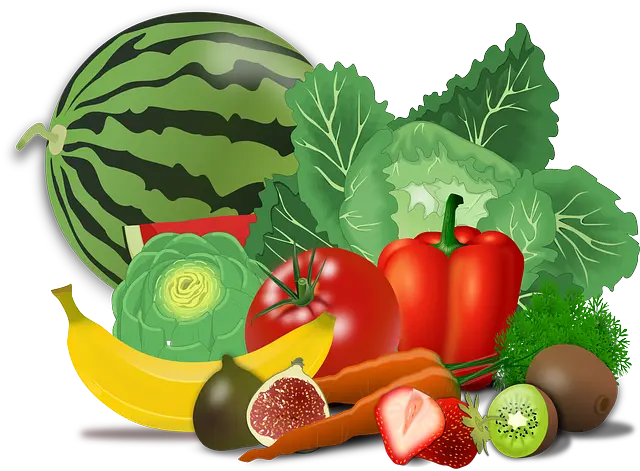Table of Contents
Introduction
Food is a fundamental aspect of human life, serving not only as sustenance but also as a means of cultural expression, an art form, and a source of comfort and joy. This article delves into the multifaceted nature of food, exploring its significance, nutritional value, types, and its role in society.
What is Food?

Any substance that living things take as food to maintain their health and viability. It is normally taken by mouth, when the digestive system breaks it down to release vital minerals and energy. These nutrients are vital for the body’s growth, repair, and various physiological functions.
Food not only provides sustenance but is also an integral part of culture, traditions, and social gatherings. Different cuisines around the world reflect the unique preferences, ingredients, and culinary techniques of various regions and communities.
It’s important to maintain a balanced and diverse diet to ensure that your body receives all the necessary nutrients it needs to function properly and stay healthy.
The Cultural Significance
it plays an integral role in cultures worldwide. It brings people together, signifies celebrations, and encapsulates tradition. Various cultures have their own unique cuisines, flavors, and culinary practices, and these aspects reflect the rich tapestry of human heritage.
The cultural significance of food is profound and varies across different societies and regions. Food is not merely sustenance; it also carries rich cultural, social, and historical meanings. The following constitute important cultural elements of it:
- Identity and Tradition: It often intricately tied to a culture’s identity. Traditional dishes and cooking methods reflect the history and values of a community. Sharing it with others reinforces a sense of belonging and cultural continuity.
- Ceremonies and Rituals: Many cultures use food in ceremonies and rituals. Whether it’s a Thanksgiving feast, a Chinese New Year banquet, or an Indian wedding with symbolic dishes, food plays a pivotal role in celebrating important life events.
- Communication and Socialization: it is Universal medium for communication. Sharing meals fosters social bonds and communication among individuals. It’s a way to express love, friendship, and hospitality.
- Culinary Diversity: it is a gateway to exploring and appreciating other cultures. It introduces people to new flavors, ingredients, and cooking techniques, promoting cultural exchange and understanding.
- Historical Context: Traditional dishes often have historical roots, tracing back to specific events, migrations, or trade routes. Studying food history can reveal much about a culture’s past.
6. Health and Healing: Traditional remedies and dietary practices are deeply ingrained in many cultures. Certain foods are believed to have medicinal properties, contributing to the overall health and well-being of a community.
7. Economic Impact: Industry is a significant driver of economic growth. It supports jobs, stimulates agriculture, and fuels tourism. Iconic dishes can become tourism attractions.
- Art and Creativity: Culinary arts are celebrated as a form of artistic expression. Chefs and home cooks alike experiment with flavors, presentation, and fusion cuisine, pushing the boundaries of what food can be.
9. Globalization and Fusion: As the world becomes more interconnected, global influences on local cuisine have become prominent. Fusion cuisine blends elements from different cultures, creating new culinary traditions.
- Sustainability and Ethics: Today, the choices we make about what we eat reflect our values. Sustainability, ethical treatment of animals, and environmental concerns have become integral to discussions about it’s culture.
In summary, it is not just a source of nourishment; it is a reflection of culture, history, and society. Its significance goes far beyond the plate, encompassing traditions, communication, and the complex interplay of various cultural elements.
The Nutritional Value

The nutritional value of it refers to the content of essential nutrients found in a particular food item, which provides energy and supports various bodily functions. These nutrients are categorized into macronutrients and micronutrients, each serving specific roles in maintaining overall health. Here’s an overview of the nutritional components of it:
- Macronutrients:
- Carbohydrates: Carbohydrates are a primary source of energy. They include sugars, starches, and dietary fiber. Whole grains, fruits, vegetables, and legumes are excellent sources of complex carbohydrates, while sweets and sugary drinks contain simple sugars.
- Proteins: Proteins are essential for building and repairing tissues, as well as supporting immune function. Good sources of protein include lean meats, poultry, fish, eggs, dairy products, legumes, and nuts.
- Fats: Fats are necessary for energy storage, insulation, and the absorption of fat-soluble vitamins (A, D, E, and K). Healthy fat sources include avocados, nuts, seeds, and fatty fish. Limit saturated and trans fats, typically found in processed and fried foods.
- Micronutrients:
- Vitamins: These organic compounds are crucial for various bodily functions, such as growth, immune response, and metabolism. Common vitamins include vitamin A, vitamin C, vitamin D, and the B-complex vitamins.
- Minerals: Minerals are inorganic nutrients vital for bone health, muscle function, and other physiological processes. Examples include calcium, iron, magnesium, and potassium.
- Trace Elements: These are minerals required in much smaller quantities, such as zinc, selenium, and iodine.
- Water: While not a nutrient, water is essential for life. It helps transport nutrients, remove waste products, and regulate body temperature. Staying adequately hydrated is critical for overall health.
- Fiber: Fiber is a type of carbohydrate that the body cannot digest. It plays a key role in maintaining digestive health, regulating blood sugar, and reducing the risk of heart disease. It’s high in fiber include whole grains, fruits, vegetables, and legumes.
- Antioxidants: These compounds, often found in fruits and vegetables, help protect the body from oxidative damage and reduce the risk of chronic diseases.
The nutritional value of it varies depending on the type of food and how it’s prepared. It’s important to consume a balanced diet that includes a variety of foods to ensure you get all the essential nutrients your body needs. Reading food labels and paying attention to portion sizes can help you make informed dietary choices to support your health and well-being.
Types of Food
Certainly! it can be categorized into various types based on its source, nutritional content, and culinary preparation. Here are some common types:
- Fruits and Vegetables: These are plant-based, rich in vitamins, minerals, fiber, and antioxidants. Examples include apples, broccoli, carrots, and strawberries.
- Grains: Grains are staple that provide carbohydrates and energy. Common grains include rice, wheat, oats, and corn.
- Proteins: Protein-rich are crucial for building and repairing tissues. They include:
– Meat: Such as beef, chicken, pork, and lamb.
– Poultry: Including chicken, turkey, and duck.
– Fish: Varieties like salmon, tuna, and cod.
– Legumes: including chickpeas, lentils, and beans.
– Nuts and Seeds: Such as almonds, walnuts, and chia seeds.
– Dairy Products: Such as milk, cheese, and yogurt.
- Dairy: Dairy products are rich in calcium and protein. Examples include milk, cheese, butter, and yogurt.
- Fats and Oils: These provide essential fats and include olive oil, coconut oil, butter, and avocados.
- Sweets and Desserts: These are typically high in sugar and include items like cakes, cookies, ice cream, and candies.
- Beverages: There is a wide variety of beverages, including:
– Water: Essential for hydration.
– Fruit Juices: including orange juice and apple juice.
– Soft Drinks: Carbonated beverages like cola.
– Tea and Coffee: Popular caffeinated beverages.
– Alcoholic Drinks: such as beer, wine, and spirits.
- Fast Food: it includes items like burgers, fries, and pizza, often served in quick-service restaurants.
- Snack: These are often consumed between meals and include chips, popcorn, and pretzels.
- International and Ethnic: A diverse range of cuisines from around the world, such as Italian pasta, Chinese stir-fry, Mexican tacos, and Indian curry.
- Organic and Health: These are often marketed as organic, non-GMO, or containing health benefits, like organic fruits and vegetables, gluten-free products, and superfoods.
- Processed and Convenience: These are that have undergone processing to extend shelf life, like frozen meals, canned soups, and packaged snacks.
- Special Dietary: Designed for specific dietary needs, including vegan, vegetarian, gluten-free, and low-sugar products.
- Spices and Condiments: These enhance the flavor of dishes and include items like salt, pepper, herbs, and sauces like ketchup and soy sauce.
- Canned and Packaged: Items that are preserved and packaged for convenience, like canned beans, pasta, and ready-made sauces.

Food choices should be made carefully to ensure a balanced and healthy diet. A variety of foods from different categories can help meet nutritional needs and satisfy individual preferences.
The Evolution of Food
The way we produce and consume it has evolved significantly throughout human history. From hunting and gathering to modern agriculture and high-tech food production, our relationship with food has transformed.
The evolution of it is a fascinating journey that spans millions of years and is intricately tied to human and environmental changes. Here’s a brief overview of the major milestones in the evolution of food:
- Early Human Diet (Prehistory): Our early human ancestors were primarily hunter-gatherers. They foraged for wild plants, berries, nuts, and hunted animals. Their diet was dependent on what was available in their local environment.
- Agricultural Revolution (Neolithic Era): Around 10,000 years ago, humans transitioned from a nomadic lifestyle to settled farming communities. This marked the beginning of agriculture, with the cultivation of crops like wheat, barley, rice, and the domestication of animals for meat and milk.
- Domestication of Plants and Animals: Over time, humans selectively bred plants and animals to optimize their characteristics, leading to the development of more productive and reliable it’s sources. This included wheat, maize (corn), and livestock like cattle, sheep, and pigs.
- Culinary Advancements: With the rise of organized societies, culinary techniques developed. Food preservation methods like drying, salting, and fermenting were utilized. The advent of pottery and cooking methods such as grilling and baking made food preparation more diverse.
- Trade and Exchange: As societies grew, they began to trade food items and spices over long distances. The Silk Road and spice trade routes connected different parts of the world and influenced the global exchange of culinary ingredients and knowledge.
- Colonialism and Exploration: European colonialism in the 15th and 16th centuries had a profound impact on it. New crops like potatoes, tomatoes, and corn were introduced to Europe, while coffee, sugar, and spices were brought back from the New World.
- Industrial Revolution: The 18th and 19th centuries brought about significant technological advancements in food production and preservation. Canning, pasteurization, and refrigeration revolutionized the food industry, extending the shelf life of perishable items and increasing accessibility.
- Fast Food and Mass Production: The 20th century witnessed the rise of fast-food chains and mass-produced convenience foods. This era also saw a significant increase in processed foods, which were often high in sugar, salt, and unhealthy fats.
- Health and Wellness Movement: As awareness of diet-related health issues grew, the latter half of the 20th century and the 21st century have seen a shift towards healthier eating habits. Consumers have become more conscious of it’s quality, organic products, and locally sourced ingredients.
- Global Cuisine and Fusion: With increased travel and multiculturalism, there has been a fusion of culinary traditions from around the world. Diverse international foods have become more readily available, and many people embrace a global palate.
- Sustainability and Ethical Food: There’s a growing focus on sustainable agriculture, reducing it’s waste, and ethical concerns about animal welfare. Organic farming, plant-based diets, and responsible sourcing are gaining prominence.
- Technological Advancements: Innovations in biotechnology, 3D printing, and lab-grown meat have the potential to reshape the future of food production and address global food security challenges.
The evolution of food is an ongoing process, reflecting changing societal values, environmental considerations, and advances in science and technology. As we look to the future, the sustainability of our food systems and the quest for healthier, more responsible food choices remain central themes in the evolution of food.
Food Production and Agriculture
Modern agriculture is a cornerstone of it’s production. However, it also raises concerns about sustainability, environmental impact, and ethical practices. Sustainable agriculture is becoming increasingly important in addressing these issues.
Food production and agriculture are integral to human survival and the global economy. These fields encompass the cultivation of crops, raising livestock, and all the activities involved in bringing it from the farm to the consumer’s table. Here are some key aspects of food production and agriculture:
- Crop Farming: Crop farming involves the cultivation of various plants for it, fiber, and other uses. Major crops include wheat, rice, maize (corn), soybeans, and various fruits and vegetables. Crop farming practices vary, including conventional farming, organic farming, and sustainable farming methods.
- Livestock Farming: Livestock farming involves the raising of animals for meat, milk, eggs, and other products. Cattle, poultry (chickens, turkeys), pigs, sheep, and goats are examples of common livestock. Animal husbandry practices are essential to ensure the well-being of these animals.
- Sustainable Agriculture: Sustainable agriculture focuses on practices that maintain and enhance environmental quality while also producing it. It involves techniques like crop rotation, reduced chemical pesticide use, and efficient water management.
- Precision Agriculture: This approach uses technology, such as GPS, sensors, and data analysis, to optimize farming practices. Farmers can make data-informed decisions about planting, irrigation, and pest control.
- Organic Farming: Organic farming avoids synthetic pesticides and fertilizers and aims to create a more natural and environmentally friendly system. Organic certification ensures adherence to strict standards.
- GMOs (Genetically Modified Organisms): Genetic modification involves altering an organism’s genetic makeup to achieve specific traits, such as pest resistance or improved nutritional content. GMOs are a subject of debate due to their potential benefits and concerns.
- Agribusiness: Agribusiness encompasses the entire food supply chain, from production and processing to distribution and retail. Large multinational corporations often play a significant role in this sector.
- Food Processing: After harvest, crops and livestock are processed into various it’s products. This includes canning, freezing, drying, and packaging. Food processing helps extend the shelf life of products and makes them more accessible to consumers.
- Food Distribution: Distribution system ensures that it’s products reach consumers efficiently. It includes transportation, storage, and the management of supply chains.
- Food Safety and Regulations: Governments and international organizations set standards and regulations to ensure food safety and quality. These regulations cover hygiene, labeling, and chemical and microbial contaminants.
- Challenges: Food production faces various challenges, including climate change, water scarcity, soil degradation, and the need to feed a growing global population. Sustainable and resilient agricultural practices are essential to address these challenges.
- Global Trade: Many countries rely on the global trade of food products to meet consumer demands and expand their markets. International agreements and trade policies play a significant role in global food production and distribution.
- Emerging Technologies: Agriculture is increasingly adopting technology, such as drones, automated machinery, and biotechnology, to improve productivity and address agricultural issues.
Sustainable and responsible it’s production and agriculture are crucial for ensuring a secure and reliable food supply, reducing environmental impact, and addressing health and nutritional needs. The future of it’s production will continue to evolve in response to changing societal needs and environmental considerations.
The Art of Cooking

Cooking is an art form that transforms raw ingredients into delectable dishes. Culinary techniques, recipes, and flavors are passed down through generations, contributing to the diverse world of cuisine.
Food and Health
Our choices have a profound impact on our health. Understanding the connection between diet and well-being is essential for preventing diet-related health issues.
Food and health are intricately connected, and the choices we make about what we eat have a profound impact on our physical, mental, and emotional well-being. Here are some key aspects of the relationship between food and health:
- Nutrition: Nutrition is the study of how our bodies use the nutrients in the foods we consume. Nutrients, including carbohydrates, proteins, fats, vitamins, and minerals, are essential for various bodily functions. A balanced diet that provides the right nutrients in the right proportions is vital for good health.
- Diet-Related Health Conditions: The foods we eat can either promote health or contribute to various diet-related health conditions. For example, a diet high in fruits and vegetables can reduce the risk of heart disease and certain types of cancer, while a diet high in processed foods can trigger diabetes, obesity, and other health problems.
- Caloric Intake: The balance between the calories we consume and the calories we expend through physical activity is critical for maintaining a healthy weight. Consuming more calories than needed can lead to weight gain, while a caloric deficit can lead to weight loss.
4. Diet that is balanced: A variety of foods from several it’s groups makes up a balanced diet. Fruits, vegetables, whole grains, lean proteins, and healthy fats should all be part of a healthy eating pattern.
- Portion Control: Paying attention to portion sizes is essential, as overeating, even healthy foods, can lead to weight gain. Portion control is a key component of maintaining a balanced diet.
- Food Allergies and Intolerances: Some individuals have it’s allergies or intolerances that can lead to adverse health reactions. Dairy, gluten, tree nuts, and peanuts all examples of common allergies.
- Special Diets: Special diets, such as vegetarian, vegan, paleo, and keto diets, have gained popularity. These diets can have health benefits when carefully planned, but they can also lead to nutrient deficiencies if not followed thoughtfully.
- Hydration: Proper hydration is essential for maintaining health. Water is necessary for digestion, circulation, temperature regulation, and waste elimination. Multiple medical issues can result from dehydration.
- Mental Health: Emerging research indicates that diet can also affect mental health. A diet rich in fruits, vegetables, whole grains, and lean proteins may reduce the risk of mood disorders and cognitive decline.
- Food as Medicine: Some of it’s have therapeutic properties and can be used to prevent or manage specific health conditions. For instance, it’s high in antioxidants can help combat inflammation, while those rich in fiber can support digestive health.
- Lifestyle and Eating Habits: The context in which we eat, such as mindful eating, socializing with family and friends, and regular mealtimes, can have a positive impact on our mental and emotional well-being.
- Food Safety: Ensuring that it is prepared and stored safely is critical in preventing foodborne illnesses.
- Cultural and Personal Preferences: Individual it’s choices are influenced by cultural backgrounds, personal preferences, and ethical beliefs. A diet that aligns with these factors can enhance overall well-being.
Overall, making informed and balanced it’s choices is a cornerstone of good health. Consulting with a healthcare provider or registered dietitian can help individuals tailor their diets to their specific health goals and needs. Additionally, regular physical activity, adequate sleep, and stress management are essential components of a holistic approach to health and well-being.
Food and Emotions
It is not just about nourishment; it can evoke a range of emotions. Comfort, for example, is often associated with feelings of warmth and happiness. The emotional connection to it is a fascinating aspect of human psychology.
The Global Food Industry
The global food industry is a vast network of production, distribution, and consumption. It encompasses everything from small local farms to multinational it’s corporations.
Sustainable Food Practices
The importance of sustainable it’s practices is growing as we address environmental and ethical concerns. Sustainable agriculture and responsible consumption are key components of this movement.
Sustainable food practices are approaches to it’s production, distribution, and consumption that aim to meet current needs while ensuring that resources are preserved for future generations. These practices focus on reducing the environmental, social, and economic impacts of our food systems. Here are some key aspects of sustainable food practices:
- Local and Seasonal Eating: Choosing its that are grown or produced locally and in-season reduces the carbon footprint associated with transportation and storage. It also supports local farmers and reduces it’s waste.
- Reducing its Waste: A significant portion of the it produced is wasted. Sustainable practices emphasize reducing it waste through better planning, storage, and consumption habits.
- Organic and Regenerative Agriculture: Organic farming avoids synthetic pesticides and fertilizers, while regenerative agriculture focuses on building healthy soil and sequestering carbon. Both methods aim to reduce environmental harm and promote long-term soil health.
- Crop Rotation and Biodiversity: Crop rotation and the use of cover crops can improve soil fertility and reduce the need for synthetic fertilizers and pesticides. Biodiversity in farming helps maintain ecological balance and resilience.
- Reducing Water Usage: Sustainable agriculture incorporates efficient irrigation practices to conserve water resources. Drip irrigation and rainwater harvesting are examples of such techniques.
- Animal Welfare: Sustainable livestock farming practices focus on the humane treatment of animals. Animals are provided with proper living conditions, access to open spaces, and natural diets. Reducing the use of antibiotics is also a concern.
- Sustainable Seafood: Choosing seafood that is sourced sustainably helps protect marine ecosystems and fisheries. Observe documents such as the Marine Stewardship Council (MSC) seal.
- Reduced Use of Pesticides and Herbicides: Integrated pest management (IPM) strategies reduce the need for chemical pesticides and herbicides, promoting healthier ecosystems.
- Forests and Permaculture: These approaches mimic natural ecosystems, using a variety of plants and trees to create sustainable, low-maintenance food production systems.
- Reducing Meat Consumption: Eating less meat, particularly red meat, can reduce the environmental impact associated with livestock farming, as well as offer potential health benefits.
- Plant-Based Diets: Plant-based diets that emphasize fruits, vegetables, legumes, and whole grains can be more sustainable and have a lower environmental footprint compared to diets high in animal products.
- Community Gardens and Cooperatives: Community-based initiatives such as gardens and cooperatives promote local food production, reduce it’s miles, and foster a sense of community.
- Preservation: Home preservation methods, such as canning and freezing, reduce the need for energy-intensive commercial it’s processing and packaging.
- Education: Educating people about the environmental and social impacts of their it’s choices helps raise awareness and encourages more sustainable consumption habits.
- Government Policies and Incentives: Governments play a crucial role in promoting sustainable food practices through policies that support organic farming, sustainable fisheries, and local systems.
- Labels and Certifications: Look for labels such as “organic,” “non-GMO,” and various sustainability certifications to make more informed it’s choices.
Sustainable practices promote the responsible use of resources, support local communities, and contribute to a healthier planet. By adopting such practices, individuals, communities, and businesses can make a positive impact on the environment and work toward a more sustainable and resilient it’s system.
The Future of Food

The future of it is a topic of great interest. Advancements in technology, genetic modification, and alternative protein sources are shaping what we’ll eat in the coming years.
The future of food is a dynamic and evolving landscape that is shaped by various factors, including technological advancements, environmental challenges, changing consumer preferences, and global economic dynamics. Here are some key trends and considerations for the future of food:
- Sustainable Agriculture: The need to produce it in a more environmentally sustainable way is paramount. Practices like regenerative agriculture, which prioritize soil health and carbon sequestration, are likely to gain prominence. Vertical farming, hydroponics, and aquaponics may also become more widespread, using less land and water.
- Plant-Based and Alternative Proteins: As concerns about the environmental impact of meat production and animal welfare grow, the popularity of plant-based proteins and lab-grown meat is on the rise. These alternatives offer a more sustainable and ethical source of protein.
- Food Technology: Advancements in it’s technology, such as 3D printing of it, personalized nutrition, and precision agriculture, are changing the way we produce, distribute, and consume it.
- Reduced it’s Waste: The focus on reducing it’s waste will continue to increase. Innovations in packaging, storage, and distribution, along with consumer education, will contribute to this effort.
- Food Security: The global population is expected to grow, placing greater demands on it’s production. Ensuring it’s security, especially in vulnerable regions, will require improved infrastructure, crop yield, and distribution systems.
- Local and Circular Food Systems: Local and regional food systems can reduce it’s miles and strengthen local economies. Circular it’s systems, emphasizing recycling and reducing food loss, will also play a role.
- Food Safety and Traceability: Consumers are increasingly interested in knowing where their it comes from and how it was produced. Enhanced traceability and transparency in the food supply chain will be essential.
- Cultural and Ethical Considerations: Food choices will continue to be influenced by cultural and ethical factors. People will seek out foods that align with their values, whether that means plant-based diets, organic foods, or sustainable seafood.
- Nutrition and Health: The link between diet and health is well-established. Nutritional science will continue to evolve, and personalized dietary recommendations based on genetics and health status may become more prevalent.
- Global Trade and Market Dynamics: International trade in food products will remain vital to meet global demand. Trade policies and agreements will shape the flow of food across borders.
- Food Policy and Regulation: Government policies will have a significant impact on the food industry. Regulations related to food labeling, safety, sustainability, and health will continue to evolve.
- Emerging Foods: New and unconventional food sources, such as edible insects, algae, and novel plant-based ingredients, may become more mainstream as sustainable protein sources.
- Consumer Awareness: Consumers are increasingly informed and conscious about their food choices. Their demands for sustainable, healthy, and ethically produced food will continue to drive change in the food industry.
- Climate Change Resilience: The food system will need to adapt to the challenges posed by climate change, including extreme weather events, shifting growing seasons, and changing ecosystems.
The future of food is a complex and multifaceted issue that requires collaborative efforts from individuals, governments, businesses, and researchers. A sustainable and resilient food system is essential for meeting the nutritional needs of a growing global population while minimizing environmental impact. As we look ahead, innovation, education, and collective action will shape the path to a more sustainable and equitable food future.
Conclusion
Food is more than just sustenance; it’s a reflection of our culture, a source of nutrition, a culinary art form, and a global industry. As we move forward, it’s essential to balance our culinary traditions with sustainable practices to ensure a nourishing and diverse future.
FAQs
Food plays a significant role in cultures worldwide, signifying traditions, celebrations, and bringing people together.
Food choices have a profound impact on our health, influencing our well-being and preventing diet-related health issues.
Sustainable food practices focus on responsible agriculture and consumption to address environmental and ethical concerns.
The global food industry encompasses everything from local farms to multinational corporations, with a vast network of production, distribution, and consumption.
The future of food is shaped by technology, genetic modification, and alternative protein sources, paving the way for innovative and sustainable culinary options.

जीरा आलू रेसिपी: एक स्वादिष्ट भारतीय व्यंजन
Table of Contents जीरा आलू रेसिपी: एक स्वादिष्ट भारतीय व्यंजन जीरा आलू रेसिपी: एक स्वादिष्ट भारतीय व्यंजन परिचय जीरा आलू, एक सरल और स्वादिष्ट व्यंजन,

Jeera Aloo Recipe: A Flavorful Indian Delight
Table of Contents Introduction Jeera Aloo, a simple yet flavorful dish, holds a special place in Indian cuisine. This delightful combination of potatoes and cumin

डोसा: एक व्यापक मार्गदर्शिका
परिचय डोसा, भारतीय उपमहाद्वीप का एक प्रसिद्ध और प्रिय व्यंजन, अपनी विशिष्टता और स्वाद के लिए दुनिया भर में प्रसिद्ध है। इस लेख में, हम

The Delectable Journey of Dosa: From South India to the World
Introduction Who doesn’t love a good dosa? This iconic South Indian dish has captured the hearts and taste buds of food lovers worldwide. But what

Paneer : A delicious Journey
Table of Contents Table of Contents Introduction This article is your passport to the delectable world of paneer, a versatile dairy delight that has captured

Savor the Flavor: Exploring Authentic Manchurian Recipes and Origins
Table of Contents Introduction Manchurian with its tantalizing flavors and diverse range of dishes, has captured the hearts and taste buds of food enthusiasts across